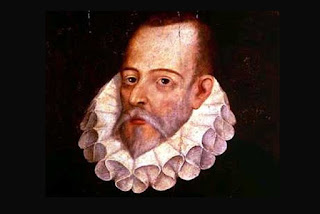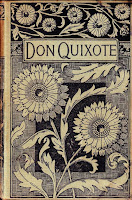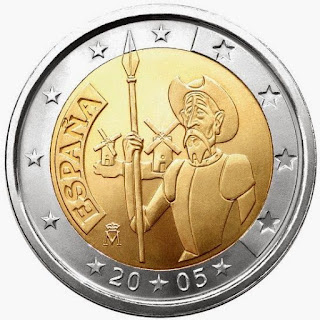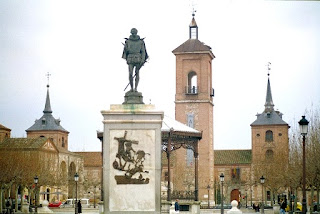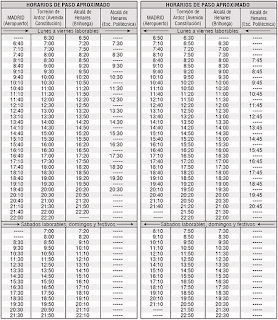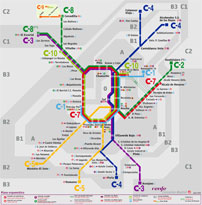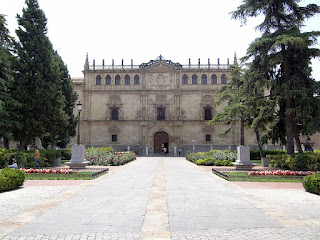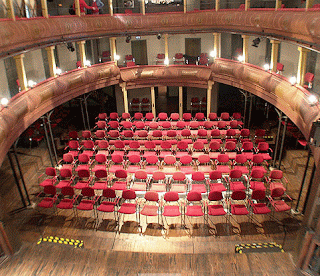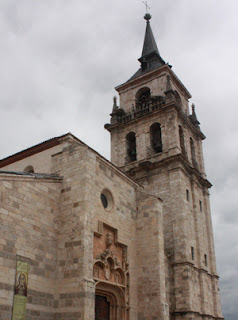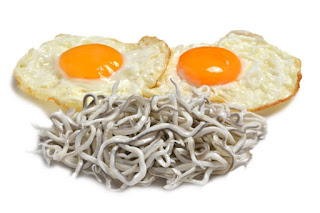There are plenty of sculptures, squares
and streets named after Miguel de Cervantes in Alcala de Henares. Why is this?
Why people in Alcala like Cervantes so much?
Cover of the book
We are going to show you some of
appearances of Miguel de Cervantes and Don Quijote in Alcala de Henares. But
first things first. Do you know who Miguel de Cervantes is?
Miguel de Cervantes
Saavedra was a Spanish novelist, poet, and playwright. His magnum opus, Don Quixote, is considered the first modern
European novel, and he is known as the greatest Spanish writer of all time, as well
as one of the best universal writers. If you’ve never heard of Don Quixote,
check out this link, and start reading
the novel today!!
Spanish, the language of Cervantes
Cervantes and Don
Quijote in Spanish coins
Have you noticed that Cervantes is
engraved on some of the spanish coins? His influence on the Spanish language
has been so great that it is often called ‘la lengua de Cervantes’ (the
language of Cervantes). This is also the reason why the official institute of
the Spanish language is called ‘Instituto Cervantes’.
You can imagine Alcalá is proud of this
fact, and therefore he appears all around the city. Let’s have a look at some
of his most important appearances!
Cervantes in Cervantes
Square
Cervantes was baptized in Alcala
The coolest thing is Cervantes was baptized in Alcalá, in Santa María’s Church on October
the 9th in 1547, and that is why we celebrate The Week of Cervantes
every year at this time.
At the end of Plaza de Cervantes are the
remains of the church where Cervantes was baptized: the tower of Santa María,
the Oidor chapel and a bit more. It was destroyed during the civil war.
Cervantes is the meeting point in Alcala
First of all, his sculpture is in the center of Plaza de Cervantes. This is the meeting
point of Alcala’s inhabitants, and we even lovingly call this statue ‘el
Monigote’ (it is translate to something like stick figure or rag doll). It is
very funny!!
It has certainly become a beloved
landmark since Carlo Nicoli designed the statue in 1878. It looks light but it
is actually made of bronze, 2’09 meters high (6 feet 10 inches) and weights 750
kgs (1653 pounds or 118 stones).
Cervantes Birthplace Museum
It is a monographic museum placed in
Calle Mayor, and housed in the building where the writer was born. It brings to
life the various areas of an affluent household during the 16th and 17th
centuries, recreating an environment intended to provide visitors with a sense
of the former residents as they went about their daily lives.
Take a photo with Don Quixote and Sancho
Panza in Alcala
At the front entrance
of the Cervantes Birthplace Museum, you’ll find a charming statue of Don Quixote and Sancho Panza. They welcome you,
and invite you to sit with them and snap a picture. In fact, it’s a must: when
you visit Alcala de Henares, you have to take a photo with Don Quixote and
Sancho Panza.
Don Quijote and Sancho
in Calle Mayor, waiting for you to take a photo with them.
The statue is the work
of Peter Requejo Novoa and was inaugurated on April 24th 2005, commemorating
the fourth centenary of the publication of Don Quixote. It is cast in bronze and life-size.
Other appearances of Cervantes in Alcala
These are the best known Cervantes
references in Alcala, but there are plenty more of them throughout the city.
For example, close to
the bus station on a rotunda in Vía Complutese you can see a giant sculpture of Don Quixote. This work was made
by Enrique Carvajal, and it belonged to a
huge exposition of sculptures that took place in Alcalá during 2008. In fact,
this was the only statue that stayed here, the 60 remaining sculptures were
moved to Toledo from where they continued their tour of Spain.
Just look around, and you can easily
spot more examples. Don’t you think it’s crazy the amount of Cervantes
memorabilia placed all around Alcalá?! Probably, it is. We are obsessed!!
